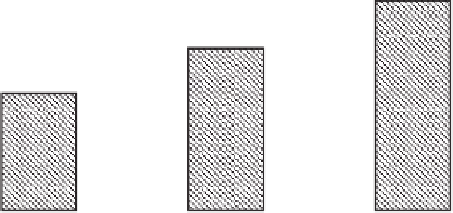Agriculture Reference
In-Depth Information
80,000
70,000
60,000
50,000
40,000
30,000
20,000
10,000
0
0
3.1x10e2
3.1x10e3
CFU/mL
Figure 18.5.
Sandwich method detection levels of bacteria inoculated onto
cantaloupe.
Detection of Pathogens Associated with Alfalfa Sprouts
The use of uncooked sprouts as a salad ingredient has gained considerable acceptance
by American consumers. However, outbreaks of
E. coli
0157:H7 and
Salmonella
spp.
associated with the consumption of raw sprouts have become a concern (Breuer and
others 2001; Brooks and others 2001; CDC 2001; Ferguson and others 2005).
Pathogenic bacteria on the seeds, if any, can rapidly grow to 10
6
- 10
8
CFU/g of product
under the warm, moist, nutrient rich sprouting conditions (NACMCF 1999; Stewart
and others 2001a). The internalization of the pathogenic bacteria into the edible parts
of the sprouts, the cotyledons and hypocotyls, makes them diffi cult to disinfect after
sprouting (Gandhi and others 2001; Hara-Kudo and others 1997; Ito and others 1998).
In 1999, the FDA recommended that sprout growers decontaminate seeds to reduce
the microbial hazards of sprouts (FDA 1999). While currently approved treatments of
seeds may reduce 99-99.9% of microbial populations, they do not guarantee a patho-
gen-free sprouted product (Beuchat and Ryu 1997; Brooks and others 2001; Jaquette
and others 1996; NACMCF 1999; Pandrangi and others 2003; Proctor and others
2001; Stewart and others 2001b; Taormina and others 1999; Weissinger and Beuchat
2000). Testing seeds for contamination is problematic due to the low levels of con-
tamination and nonuniform distribution of pathogens (Splittstoesser and others 1983).
The FDA has recommended testing spent irrigation water from sprout production
for the presence of
E. coli
0157:H7 and
Salmonella
spp. (FDA 1999). Testing spent
irrigation water has many advantages over testing sprouts. In order to test the sprouts,
multiple samples must be taken from various areas of the sprouting drum to ensure
that the sampling is representative of the microfl ora present. Also, pummeling of the
sprouts to break them open prior to testing, as recommended by the FDA (FDA 1999),
may release phytoalexins inhibitory to the growth of some pathogens during enrich-
ment or isolation (Jaquette and others 1996). The only disadvantage of testing spent
irrigation water is that the level of microorganisms recovered is generally 1 log lower











